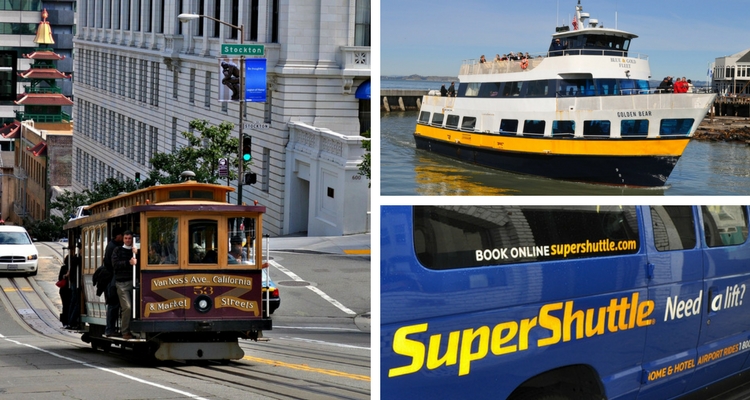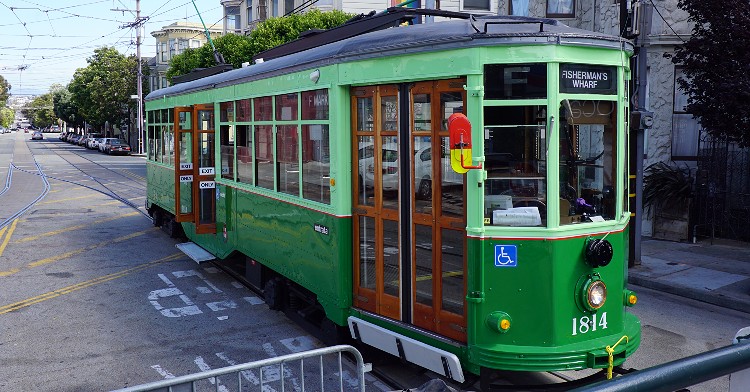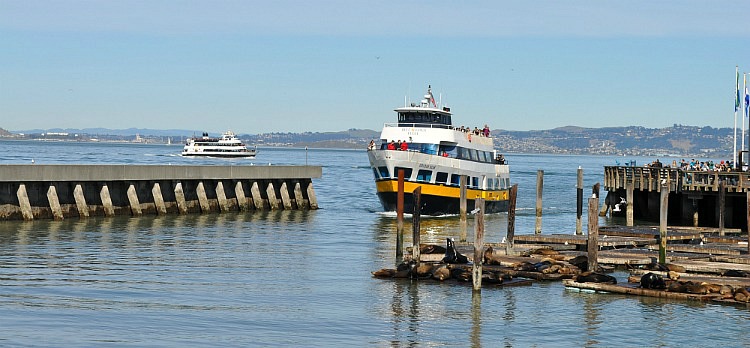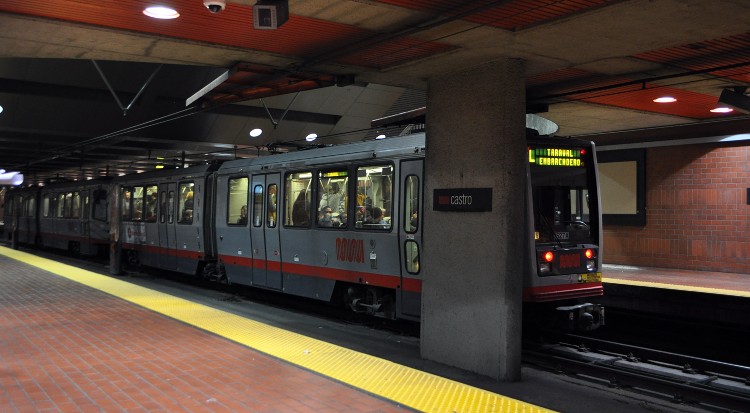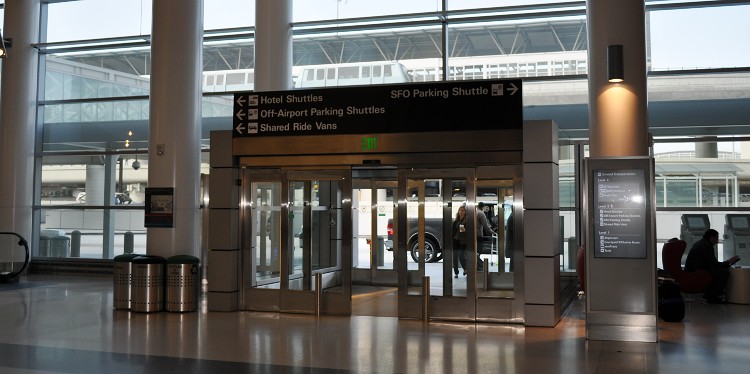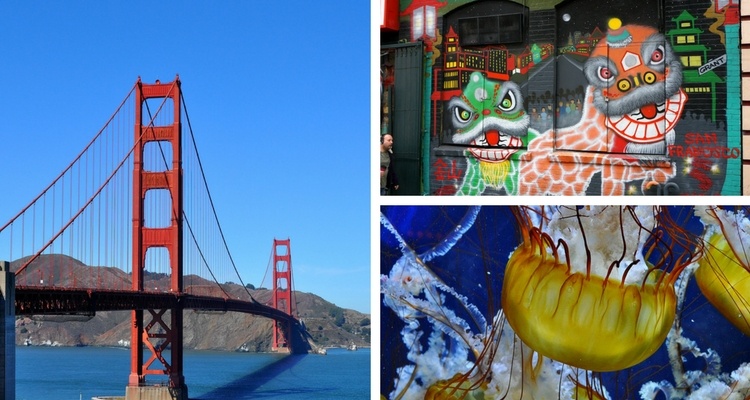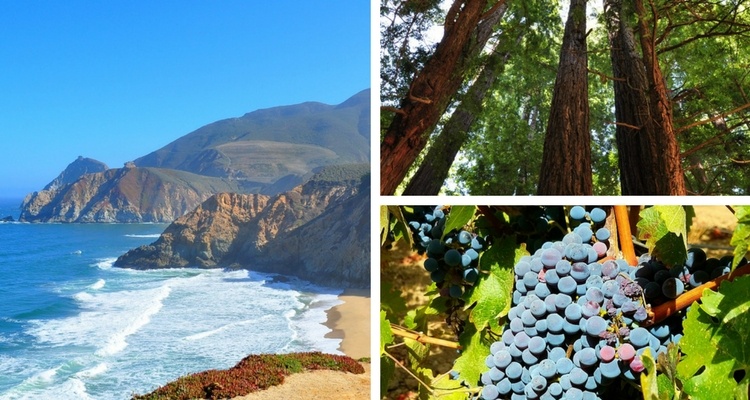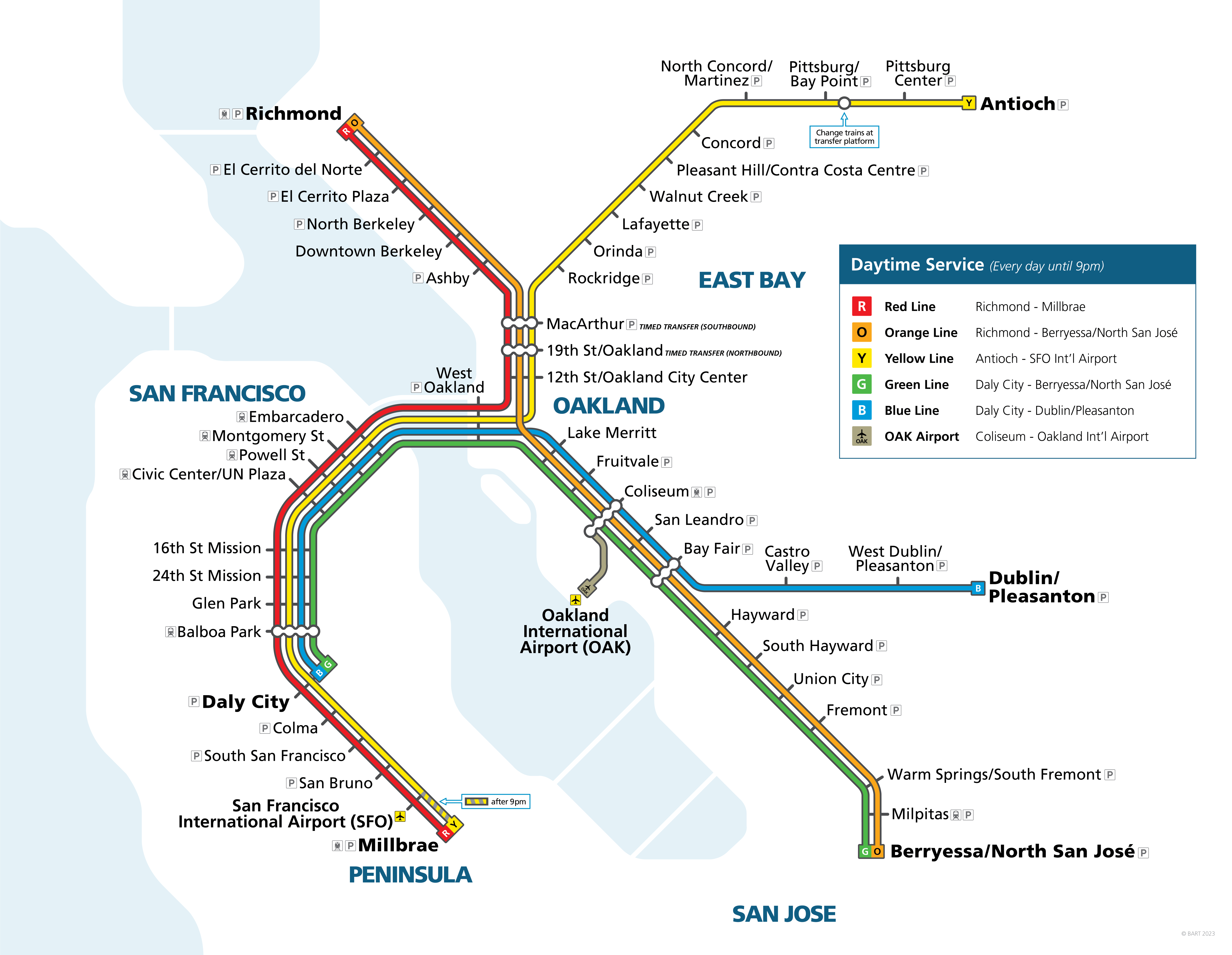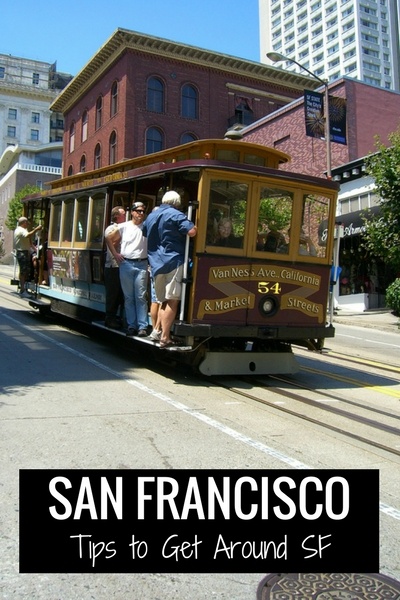SIGN UP FOR MY EMAIL TO RECEIVE YOUR FREE SAN FRANCISCO PLANNING GUIDE.
- Home
- Plan Your Visit
- Getting Around SF
Getting Around San Francisco: Public Transportation, Parking, & Cable Cars
By: Jill Loeffler • Updated: July 1, 2025
Getting around San Francisco is easy with our wonderful public transportation options. You can use the bus, ferry, cable car, streetcar, or train.
My transit guide includes up-to-date fares, how to pay, and the best options to get to popular neighborhoods and attractions.
In addition, I've provided some tips for those who plan to drive, need some help selecting the right airport, or want to know how to get to other places in the Bay Area and beyond.
SFTourismTips is made possible by readers like you! If you book through my links, I may earn a small commission at no extra cost to you. Thanks for your support! Learn more.
Table of Contents
- San Francisco Public Transportation Options
- Additional Ways to Get Around SF
- Cost & How to Pay for SF Muni
- MuniMobile vs. Clipper
- How to Get from SFO to SF
- Best Public Transit for Top Attractions
- Best Public Transit for Top Districts
- Getting Around the Bay Area and Beyond
- Public Transportation Options for Tourists with Disabilities
- Getting Around for Special Events
SF Public Transport: Buses, Streetcars, Cable Cars, and Light Rail
One of the best ways to get around San Francisco is by using the many public transportation options. Our SF Muni system includes buses, light rail trains, cable cars, and streetcars.
Find out about each one, including some of the best lines to use between top districts and attractions.
SF Muni Buses
The most used option for San Francisco public transportation is the bus. There are over 50 different bus lines that take people throughout the city. This is a popular option for locals, which means some buses can get pretty crowded.
However, this is a great option to help you save a little money while you are here. The following are the most popular San Francisco bus routes for visiting prime attractions:
1 California Street: This bus line cuts straight across the city, east to west. It covers 14 districts starting from downtown through Nob Hill. You can use this bus to get you up the steep hill to visit Grace Cathedral, the Fairmont Hotel, or some of the other historical sites in Nob Hill. It also heads through Chinatown.
7 Haight-Noriega: This San Francisco public transportation bus also runs along Market Street and heads to the famed Haight-Ashbury district. You will ride through a few neighborhoods along the way. It’s an easy and safe option to get you over to this SF district that was a hub of activity during the 60s and 70s.
14 Mission: This transit bus goes diagonally southwest along Market Street. It will take you to the Mission District, where you can visit the historic Mission Dolores or enjoy some great food.
30 Stockton: This is a really popular and really busy bus. It runs through Union Square, then through Chinatown, through North Beach, stops just a few blocks away from Pier 39 and Fisherman's Wharf, and finally ends up in the Marina District.
39 Coit: This bus runs from North Beach up the hill to Coit Tower. This bus line is really short, but it is a great option if you don’t want to trek up the large hill to visit Coit Tower in San Francisco.
>> Find additional options to get to and from Fisherman's Wharf and our top attractions
SF Muni Light Rail Trains
The next San Francisco public transportation option is the Muni Metro, or light rail trains.
There are five train lines that run underground along Market Street between the Embarcadero and Civic Center, and one that crosses Market from Chinatown to South of Market (SOMA).
Beyond the busy downtown area, these lines come above ground and take passengers to destinations like Oracle Park, the Castro District, the SF Zoo, and more.
Here is a quick description of each line:
J-Church: This line goes along Market Street to the Castro. It then continues on to Noe Valley.
K-Ingleside: This one runs along Market Street and services City College.
L-Taraval: This line takes you all the way through the southern end of the Sunset District out to the SF Zoo.
M-Ocean View: This one runs down Market Street through West Portal to SF State University.
N-Judah: This train takes you to Haight-Asbury, Cole Valley, and through the Sunset District all the way out to Ocean Beach. It's also a great option for getting to and from Golden Gate Park.
T-Third Street: This is the newest train line, opened in early 2023. It takes passengers from Chinatown, through Union Square, past the King Street Caltrain Station, by the Chase Center, and farther south.
SF Muni Cable Cars
One of the most popular San Francisco public transportation options is our famed cable cars. Even if you aren't heading to a specific destination, I’d highly recommend taking a cable car ride while you are here.
There are three lines still in operation. Two run between Fisherman's Wharf and Union Square. The other runs east-west along California Street.
>> Find a map of the Cable Car routes, tips for avoiding the long queues, and more
SF Muni Streetcars
The F is the only streetcar line (service with the E is suspended) in the San Francisco public transportation system.
These vintage streetcars run from the Castro along Market Street, through Union Square, and then up the Embarcadero to Pier 39. This line also stops across from Pier 33, where you can take a ferry to visit Alcatraz.
The electric-powered vehicles are all remodeled above-ground streetcars from different cities around the world. The ride is a little jerky at times, but it is a fun way to see the city as you head to your destination.
Oh...and the seats are usually small, so get ready to cozy up with your neighbors.
>> Learn more about the historic F Streetcar line and the SF Railway Museum
Additional Ways for Getting Around San Francisco
Walking
If you're a real explorer, walking is the best way to get around San Francisco. SF is small, and you can easily get to many destinations on foot.
It might take a little longer, but it will allow you to stop along the way to check out our colorful murals and admire some of our hidden gems.
I've created some itineraries to help you plan out your visit and see as much as possible. This will allow you to explore on foot and utilize transportation options.
>> Find some great walking tours around SF
Rent a Bike
You can also head out on a bike ride to see even more. Many people use this option for getting around San Francisco, including rides over the Golden Gate Bridge to Sausalito.
You will find several places to rent bikes in Fisherman's Wharf. You can either book in advance or walk in to check them out before you rent. I find that most of the companies along the waterfront are similar in price and quality.
You can also rent e-bikes if you prefer that your bike pick up some of the hard work around SF's steep hills!
>> Check out this deal on Groupon to save on your bike rentals
Bike Share Service
San Francisco also has a large bike share network. You can use the system through the Lyft app, the same one as the ride-sharing service.
Once you find the bike you want to use, simply tap on the bike icon, scan the QR code on the bike (on the rear fender), and it will unlock the bike for your use. You can then ride it around as long as you want.
Once you are done with the bike, either find a Bay Wheels station to drop it off or use the bike cable to lock it to any bike rack in the service area. Follow the prompts on the app to return the bike, and you will be automatically charged for your trip.
Bay Wheels offers both regular and e-bikes. The e-bikes cost more, but make getting around San Francisco easy.
Ferry Systems
With so much water around the city, sometimes taking a ferry will save you some time. And, it's so much fun! Click through to find out more about the different ferry options, including schedules, prices, and other tips for riding the SF ferries.
The Golden Gate Ferry and the San Francisco Bay Ferry offer routes to and from Angel Island, Marin County, Oakland, Vallejo, and more. They also offer routes to and from major sporting events in the city of San Francisco.
Hop-On Hop-Off Buses
If you prefer to get directly from one attraction to the next, you will find that getting around San Francisco on a Hop-On Hop-Off Bus is quite easy.
You simply hop on the bus at one of its stops. You can then hop off and on again at any stop on the route.
With this option, you can easily get to the Golden Gate Bridge, Golden Gate Park, and several locations in between.
All of these open-air double-decker buses pick up and drop off at the same locations, so you know exactly where to wait for the next bus to arrive.
They run from about 10 am to 6 pm, and you can buy tickets for 1 or 2 days.
The entire route takes about 2 to 2.5 hours if you don't get off and just enjoy the tour with the narration. However, with all the stops you will want to make, it will most likely take you a day or two.
>> Find more details on our Hop-On Hop-Off Buses
>> Book tickets for the Hop-On Hop-Off Buses
Guided Tours
Another popular way to get around San Francisco (and beyond) is through a guided tour. You can do a bus tour of the city, take a day tour to Muir Woods, or head up to wine country.
You can also do a guided tour by GoCar, bike, or on foot. With an expert guide, there is no better way to see San Francisco.
>> Find a full list of top tours around San Francisco
Taxis & Rideshare Services (Uber & Lyft)
Taking a taxi has always been one of the most popular options for getting around San Francisco. It's fast and easy. However, it's a little more expensive.
Nowadays, many people use the rideshare apps Uber and Lyft. You will find they are very competitive and, in some cases, even less expensive than a taxi.
A novel option now open to the public is the Waymo self-driving car, which operates with a similar app, but without the human driver! It's a fun experience, and quite safe—but I don't recommend it if you're in a hurry!
>> Read my tips on taking taxis in SF and from SFO, as well as going rates between popular destinations
Pedicab
Have you seen the small cabs being pulled around by bike? Those are pedicabs, and they are another fun way to get around San Francisco.
Most offer rides along the Embarcadero between the Ferry Building and Fisherman's Wharf. You can also request that they take you to Oracle Park.
Their routes are limited to avoid slowing down traffic on busy streets, but they offer a fun way to travel.
Bay Area Rapid Transit (BART)
We also have a subway train called the Bay Area Rapid Transit (or BART). There are eight stops within the city of San Francisco.
It's also a great option to get between the city and the airport, as well as other cities around the area. You can learn more about it here.
The most popular stops in San Francisco, working from the waterfront inland, are:
- Embarcadero - closest to the Ferry Building, also a transfer point to the F streetcar to get to Fisherman's Wharf
- Montgomery Street - right in the heart of the Financial District
- Powell Street - closest to Union Square and the cable car turnaround
- Civic Center/UN Plaza - a central stop for exploring our downtown museums and performing arts venues
Rental Cars
Renting a car is expensive and not necessary for getting around San Francisco.
However, it can be a great option for day trips. If you plan to visit areas around the SF Bay or beyond, such as Muir Woods, Napa, or Yosemite, you will find several places for rentals.
You can either pick up your vehicle at SFO when you arrive or pick one up for a few days right within SF. The second option is best if you only need the car for a day or two.
My guide offers tips on where to find rental car companies in key districts as well as a few things to think about before you rent.
>> Details on renting a car in SF
San Francisco Parking and Garages
If you decide to brave the parking scene, there are a few options in the city. Parking on the street is the cheapest option, but it is tough to find. It's also hard to find a spot that isn't limited to only those with parking permits.
The best option is to find a parking garage. There are a number of garages in Union Square and Fisherman's Wharf. You can also park at your hotel, but all of these options can be expensive.
Garages in Union Square and Fisherman's Wharf are pricey, with rates ranging from $25 to $70 a day. Most hotels will also charge anywhere from $20 to $70 a day, but these spots are more secure than a standard parking garage.
Parking is also difficult around the Golden Gate Bridge, so I created this page to help you find a few great options before you arrive.
>> Find parking tips and the best garages in top districts
Cost and How to Pay for SF Muni
Here are a few answers to questions about how much it costs, how to pay, and where to buy tickets when using SF Muni.
There are three ways to pay for your Muni fare on San Francisco's buses, cable cars, streetcars, and the light rail trains.
SF Muni Fares
Here are the current ticket prices to ride Muni:
- Single Ride Cash: $3
- Single Ride MuniMobile/Clipper: $2.85
- MuniMobile Unlimited Day Pass: $5.70 (excludes cable cars)
- Cable Car Single Ride: $9
- Muni 1-Day Visitor Passport: $15
- Muni 3-Day Visitor Passport: $35
- Muni 7-Day Visitor Passport: $47
You'll find five ways to pay for transit below.
1. MuniMobile App: Best Option
The MuniMobile app is a great money- and time-saving option for getting around San Francisco on public transportation.
I think it's the best option, as it's easy for both you and the transit employees. You can also get a Day Pass or a Visitor Passport, so you don't have to worry about buying a ticket for each ride.
To use this option, you'll need to download the MuniMobile app.
Per Ticket Price: The per ticket price for adults when using MuniMobile is $2.85. This is good for 120 minutes of travel. Before you hop on the bus, simply open the app and select the single ticket purchase option. Once on the bus, scan your ticket on the screen at the ticket scanner located at either the front or back door.
Day Pass: The Day Pass is a great savings option if you plan to use San Francisco's public transportation several times in one day. The pass is just $5.70 per person and allows you unlimited rides for the day on Muni buses, streetcars, and trains. NOTE: It does not include cable car rides.
Visitor Passport: Another great option is our Visitor Passports. They are offered as 1-, 3-, or 7-day passes. They include unlimited rides on buses, streetcars, and trains. This option includes unlimited rides on the cable cars.
- 1-Day Muni Passport: The 1-Day Passport using MuniMobile is $15 per person.
- 3-Day Muni Passport: The 3-Day Passport using MuniMobile is $35 per person.
- 7-Day Muni Passport: The 7-Day Passport using MuniMobile is $47 per person. If you are staying for five or six days, this option is a better deal than buying two 3-day passes or a 3-day and a 1-day pass.
To use the passport, open it and wave it over the ticket scanners located at the front or back of the bus, train, or streetcar. On the cable cars, one of the drivers will scan your passport with their hand scanner. The passport is activated the first time you use it on any Muni transit option.
It will then run out at 11:59 pm on the first, third, or seventh day after you use it for the first time. It will not skip a day or extend your days if you take a break for a day or two.
If you are staying longer, you can also buy a monthly pass through the MuniMobile app.
Note: BART is not included with the MuniMobile day passes or visitor passports. You would need to buy a Clipper card for these rides (see below).
>> Visit the SF Muni site to learn more about the Muni Passport
2. Using Cash on SF Muni
All four modes of Muni transportation allow you to pay by cash. However, since cash slows down the process to ride, it costs more per ride with this option.
For the buses and streetcars, you'll pay at the front with bills and coins. Make sure you have the exact amount as they don't offer change.
The light rail trains are on tracks both on the streets and underground. When the train is above ground, you'll also pay in cash at the front.
They don't give change either, so make sure you have exact change. If you go to a station that is underground, you'll need to buy a ticket at one of the kiosks (which accept cash, credit cards, or debit cards and do offer change).
The current cash price to ride the bus, trains, or streetcars on SF Muni is $3 for adults. You will also receive a transfer that you can use for 120 minutes.
This allows you to transfer to a new bus or take a second bus to a new destination without paying. The transfers can be used on the light rail, buses, and streetcars only.
On the cable cars, you'll pay one of the two people working the system. They only accept exact change, so make sure you have exactly what you need to pay for your fare before you hop on.
The cash price for cable cars is $9. They do not offer transfers, so if you do want to hop off and then back on, you will need to pay a second time.
3. Clipper Card
The third option for paying is the Clipper Card. This card allows you to use a few different transit systems, including those that take you outside San Francisco.
I only recommend this one for those who stay outside SF and plan to use other transit systems such as BART, Caltrain, and the Golden Gate Transit System frequently. You can also use it on SF Muni Metro, but you don't need it unless you plan to use other transit systems around the Bay Area.
This is more of an option for locals or those planning to stay more than a couple of months in the area. It's also for short-term visitors staying outside of the city and will need to frequently use other transit options to get in and out of SF.
The first thing to note about the Clipper Card is that you can either get in through their app or pay for a physical card. The app is the best option as a physical Clipper Card costs $3. This $3 charge is non-refundable.
Pay for Individual Rides: The way the Clipper Card works is that you can add any amount of money to your account. You will then swipe the card when you jump on any SF Muni, BART, Caltrain, or other SF Bay Area mass transit options. The specific Clipper Card amount will be deducted from your account without you having to grab cash for each transaction. You will often get a small discount for your rides when you use the Clipper Card versus paying cash.
Muni Passports: You can purchase the Muni Passports using the Clipper Card app.
Monthly Passes: You can also use the Clipper Card to buy a monthly pass for Muni, a combined monthly pass for Muni and BART, and other transit systems around the SF Bay Area. Each one works in a slightly different way, so you'll need to check out each option before buying.
Where to Buy Tickets for SF Public Transit
Now that you know all three options for paying, you may be asking where you buy your tickets. Here is a little more information.
Single-Use Tickets: You can use a credit card, cash, or debit cards at the ticket machines in the underground stations near downtown San Francisco. You can also use either your MuniMobile App or the Clipper Card for single-use tickets. You can pay directly on most transit systems using cash. Note that BART no longer offers single-use paper tickets.
One Day Muni Passes: This pass is just $5.70 and includes unlimited rides on Muni buses, light rail trains, and streetcars. You can buy this through the MuniMobile App or at a ticket kiosk at one of the underground stations near downtown SF. This option is inexpensive, but it does not include rides on our cable cars.
Visitor Passports: The best place to purchase these is through the MuniMobile app. You can also buy them at ticket kiosks in the underground stations at the Embarcadero, Montgomery Street, Powell, the Civic Center, and Van Ness Street. They cost quite a bit more when you buy them through the kiosks. The final option is to buy them through the Clipper Card, which is the same price as buying them through the MuniMobile app.
MuniMobile vs. Clipper
There is a lot of confusion about the difference between MuniMobile and Clipper. Since I'm asked about it a lot, I thought I would do a quick comparison to help you select the right one for your stay.
Make sure to also read the section above, which offers quite a bit more information about each option.
- MuniMobile is exclusively for use on San Francisco Muni services, including cable cars, streetcars, buses (with the Muni logo), and light rail trains.
- Clipper Card is a combined card that can be used for most Bay Area transit systems. This includes SF Muni, BART, Golden Gate Transit, SamTrans, ferries, and Caltrain.
- MuniMobile is a prepay system, so it allows you to buy single tickets, Day Passes, and Muni Passports in advance of your ride.
- The Clipper Card allows you to pay in two different ways. You can buy monthly passes or Muni passports in advance. To pay for single rides, you must add money to your Clipper Card account. Money will be deducted from your account when you swipe your card for single rides. You must refill your account when it runs low.
- MuniMobile allows for instant access to tickets purchased through its app.
- If you reload your Clipper Card value online, you may have to wait two or more days before you can use it. However, any value you add in person or through your phone's mobile wallet should be available immediately.
- MuniMobile tickets and passes expire after 90 days, even if they are unused.
- The money in your Clipper Card account does not expire, and you can use it when you return. However, if you plan to only visit the area once, it's difficult and time-consuming to get a refund on the money left over in your account. Make sure to plan out your use of the card, so you don't get left with a large balance that takes some time to get returned.
How to Get from SFO to San Francisco
There are a few ways to get from SFO to San Francisco. Here are some of the most popular options.
SFO Shuttles: Pre-COVID, shared vans were a cost-effective way to get from SFO into the city or the surrounding communities. Several companies run these shuttles, but most of them currently offer private charters only.
BART: The BART train is another great way to get from SFO to San Francisco. It's perfect for travelers who are traveling light and can walk to their hotel (or take an Uber/Lyft/Taxi) from one of its SF stations.
Uber/Lyft/Taxi: You can also use a ride-hailing app to request a car. Taxis are readily available outside Arrivals. Both options will cost anywhere from $35 to $70 before tip/taxes to get to places throughout SF.
>> Specific tips for getting from SFO to Union Square
>> More details about getting from SFO to Fisherman's Wharf
Flying in? Visit my airport page to learn more about the San Francisco International Airport (SFO).
Best Public Transportation for Top Attractions
Here are a few tips for getting around San Francisco to key attractions. They include some of the most popular Muni routes.
Alcatraz: The F streetcar will take you directly to Pier 33, where you will take the ferry to Alcatraz Island. You can pick it up in Union Square or Fisherman's Wharf.
Angel Island: The only way to get to Angel Island is by ferry. It is operated by Golden Gate Ferry and leaves from the Ferry Building. The best way to get to this ferry terminal is on the F streetcar.
Oracle Park: The N Judah and T Third Street light rail lines drop off right in front of Oracle Park. This is where the SF Giants play.
Baker Beach: The easiest way to get to Baker Beach is by picking up the Presidio GO Shuttle in downtown SF. This will take you to the Presidio Transit Center, where you can then hop on the South Hills Route shuttle to get to Baker Beach. You can also take the 1 or 38 bus from Union Square and downtown SF, transfer to the 29 (get off at Lincoln Boulevard and Bowley Street), and walk about a half-mile to the beach.
I will also sometimes grab the 1 and then walk from the stop at 25th Avenue & Geary over to Baker Beach. It's just under a mile, which will save you time compared to waiting for the bus to take you that half mile to the beach.
Golden Gate Bridge: You have two options for getting around San Francisco and over to the Golden Gate Bridge. Muni offers a bus that will take you right to the Visitor's Center on the southern side. It's the 28, and you will need to transfer over to this bus if you are coming from Union Square or Fisherman's Wharf. This is the slower, but less expensive option.
You can also get on any Golden Gate Transit bus (101, 130, or 150) from downtown SF. All of them stop at the Golden Gate Bridge. It's easier, as you don't have to transfer, but it will cost about twice as much per person. The bus drivers might discourage you from taking this bus, but tell them you are okay with the added fee as it's a more direct route (NOTE: This is separate from Muni)
Golden Gate Park: To get to Golden Gate Park, you can take the N Judah or the 5 Fulton. The N Judah runs on the southern end of the park, and the 5 Fulton runs along the northern edge of the park. From there, you can walk to your destination inside Golden Gate Park.
Pier 39: This is another top destination. You will find several options to get to Pier 39. You can take the Powell-Mason cable car from Union Square or the F streetcar.
Twin Peaks: If you want to climb to the top of Twin Peaks for amazing views around SF, then head over to the Castro Street Station first (F streetcar or the K, L, or M light rail trains). From here, transfer over to the 37 bus and get off on Crestline Drive. This is where you will find a set of stairs that will take you first to the main road, and then you can climb one or both of the peaks.
Getting Around San Francisco: Districts
Here are a few tips for getting around San Francisco to some of our top districts.
Castro: There are a variety of options that will take you to the Castro District. The F streetcar is slow, but a fun ride. You can also take the faster light rail trains. The J, K, L, and M trains all stop at the Castro Street station.
Chinatown: In addition to walking to the centrally located Chinatown, you can take the 30 or 45 bus, or any of the three cable car lines (to get within a few blocks of Chinatown). You can also take the T-Third Street light rail to the Rose Pak station.
Civic Center: The Civic Center District also offers a variety of SF transit options. You can take the F streetcar or the K, L, M, N, or J light rail trains. This is where you can visit the Asian Art Museum, City Hall, and performing arts options such as the symphony, ballet, theater, or opera.
Fisherman's Wharf: You can get to Fisherman's Wharf on the F streetcar. You can also get here on two of the three cable car lines (Powell/Hyde & Powell/Mason). All of these options are a great way to get around San Francisco and to popular destinations in this district.
Haight-Ashbury District: The Haight-Ashbury District is another top neighborhood to visit during your stay. The best bus for this district is the 7, which will take you right along the main commercial area on Haight Street.
Mission: You can get to the Mission on the 14, 22, or 49 buses. You can also take BART from downtown.
Nob Hill: Reach the top of Nob Hill on the California cable car. Other options include walking up its steep hills or taking the 1-California bus.
North Beach: North Beach is a fun place to visit and is home to the Beat Generation of the 1950s and 1960s. You can reach it on the 30 and 45 buses. You can also reach it on the Powell/Mason cable car line. If you love walking, it's also a nice walk from both Union Square and Fisherman's Wharf.
Union Square: Union Square is in the heart of the city and is serviced by dozens of public transportation options. You can get here by light rail, bus, and all three cable car lines. You can also use BART or the F streetcar line. More tips for getting to and from Union Square.
Getting Around the Bay Area and Beyond
There are great ways for getting around the entire Bay Area on public transportation. This section provides some tips and information on these three options.
BART
Another great public transportation option is BART, the Bay Area Rapid Transit system. This train system services eight stops in San Francisco and dozens more across the Bay.
BART runs from San Francisco south, down the Peninsula to SFO, and east, to Oakland, the Oakland International Airport, and beyond.
In the city, this train system runs mainly underground along Market Street. You can also use BART to get to and from Union Square to the Civic Center District and on to the Mission.
The BART map below is the official map from their website. It shows all of the routes and many of the main stops along the way. You can also plan your trip by visiting the official BART website.
Fares vary depending on the distance between the BART station where you board and the station where you get off. They range from around $5 to $15 per person.
How to Pay to Ride BART
Since BART is separate from SF Muni, I wanted to separate this piece out to explain the different ways to pay for it and where to find tickets.
Clipper: You'll probably either pay with a plastic Clipper Card (which costs $3 to acquire the first time) or a digital Clipper Card on your phone (which is free to download and uses Apple or Google Pay). If using the physical card, refer to the fare chart at the vending machine and insert cash or a debit or credit card to load the amount needed. You can always load more than needed and use the balance for future trips, but beware that you probably won't recover any unused credit on your card.
Muni/BART Combined Monthly Pass: This is also an option, but only a good idea for those planning to stay for a month or more.
NOTE: Rides on BART are not included in the MuniMobile app, the Muni Day Pass, the multi-day Visitor Passports, or the standard monthly Muni pass.
Caltrain
Caltrain is another train system with two stops in San Francisco. It’s mainly used for those traveling to and from the peninsula and all the way down to San Jose.
It’s a great option for those coming to and from Oracle Park for games. It’s also used by those commuting in from San Jose or from SF down to San Jose.
The train station in the city is located in the South of Market area at 4th and King Streets. The trains run about once an hour both northbound and southbound on the weekend. They run a little more frequently during the week, specifically around the morning and late afternoon commute times.
Caltrain charges rates by zones, and each station is listed in a specific zone. If you take the train from Zone 1 to Zone 6, which is as far south as it goes, the cost is around $15 per person one way. If you stay within one zone, the cost is only $3.75 per person one way.
You are required to pay for your ride before you board. Caltrain does not sell tickets onboard, and someone always comes around to check that passengers have paid. Passengers who have not paid are subject to a fine.
You can either purchase a ticket at the station—there are usually one or two kiosks in each station where you can use cash or a credit card—or use the Clipper card or the Clipper app—which you may already have if you also rode BART or Muni. If using Clipper, there are machines on the platforms where you need to tap your card or phone to pay.
Golden Gate Transit
Another option for getting into and out of the city is the Golden Gate Transit system. This public transportation option in San Francisco focuses on people wanting to get to and from Marin County, north of the Golden Gate Bridge.
Golden Gate Transit runs several buses to and from the counties north of San Francisco. They also have their fares set up in zones, making it easy to see what it will cost you to get around.
If paying with cash, you will board the bus and tell the driver where you are going so they can determine the appropriate fare. It is best to have exact change because the bus drivers do not give change. If you are due more than $1 in change, you will be given a Change Card that can be used on future rides.
An easier way to pay is by using the Clipper card or app, which also offers discounted fares and simply subtracts from the money you have loaded in your account.
To get from San Francisco to Petaluma or Santa Rosa in the farthest zone (Sonoma County), the cost is around $14 one way, per person (or $11 with Clipper). To get to Sausalito or Tiburon in the closest zone (Marin County), the cost is around $8 (or $7 with Clipper).
Getting from SF to Places Outside the City
Here are a few details on getting from San Francisco to popular destinations in the SF Bay and beyond. I've included times to get there as well as the best public transportation where available.
SF to/from Muir Woods: There are three ways to get to Muir Woods from San Francisco. You can drive (parking reservations are now required), take a shuttle from Sausalito, or go on a guided tour. Muir Woods is about 45 minutes north of San Francisco by car.
SF to/from Oakland: The best way to get over to Oakland from San Francisco is BART. There are several stops downtown. You can also get to the Oakland Coliseum or to the Oakland International Airport on BART.
SF to/from San Jose: You can either take Caltrain or drive to San Jose. Both the train and driving will take about 1 hour and 30 minutes.
SF to/from Berkeley: BART is your best option to get to and from Berkeley. There are three stops with access to Berkeley. Ashby will get you to the southern side of town, Downtown Berkeley will put you right in the heart near the UC Berkeley campus, and North Berkeley will get you to the northern end. You can also drive to Berkeley, but parking can be challenging here.
SF to/from Marin: Marin is just to the north of San Francisco across the Golden Gate Bridge. You can access a fair amount of Marin by ferry or bus. You can also drive if you are heading to a location that is not near a public transit stop.
SF to/from Napa Valley: The best way to get to Napa is to either drive or take a guided tour. While you can take public transit to get there, it will take more than 3.5 hours in total with transfers. If you drive on your own, it will take just over 1 hour to reach the southern end and about 1 hour and 45 minutes to reach Calistoga on the northern end. Here are a few more tips to get between SF and wine country.
SF to/from Santa Rosa: You can also easily access Santa Rosa by bus or car. Golden Gate Transit offers a stop in Santa Rosa on their 101 bus. This takes about 2.5 hours and runs every hour. You can also get here in just over 1 hour by car.
SF to/from Half Moon Bay: Half Moon Bay is about a 45-minute drive south of San Francisco. Driving is easy. However, if you want to take public transportation, that is also an option. It will take about 1.5 hours with two to three transfers.
Public Transportation Options for Tourists with Disabilities
Most of the San Francisco and Bay Area transit systems are accessible to tourists with disabilities.
Here are a few more details.
- BART and Muni stations include elevators to access above-ground or underground trains.
- Several streetcar and light rail train stops offer wheelchair accessible ramps.
- Buses offer wheelchair accessible ramps and dedicated areas for wheelchair users. There are also straps to keep your wheelchair in place as you ride around San Francisco.
- There are tactile maps of the Muni stations/stops with Braille and raised characters.
Unfortunately, our historic cable cars are not wheelchair accessible. Due to their design, these historic vehicles do not offer space and/or ramps for wheelchair users to access them.
Getting Around for Special Events
You will also find additional services for certain special events and holidays.
SF Muni, BART, and Caltrain often work together to offer additional trains, buses, and shuttles for annual fireworks displays, large festivals, and more.
You will also find special ferries that run to both Oracle Park and the Chase Center for our professional sports teams.
Find out more about the following events:
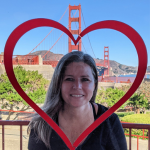
Hi, I’m Jill!
I’ve been sharing San Francisco travel advice since 2009 and have helped millions of people explore the city like a local. Whether you’re dreaming of sea lions, cable cars, or a great sourdough bread bowl, I’m here to help you plan an unforgettable trip with real tips from someone who actually lives here.
Comments? Questions? Suggestions?
I would love for you to join me in my private Facebook group!
It's a great place to interact with me and others who are familiar with the area.
You can ask questions, get advice for your upcoming stay, and then share your photos and advice with others when you return home. It's a great community and the fastest way to get answers to those nagging questions about your visit!
